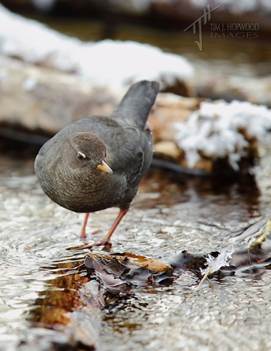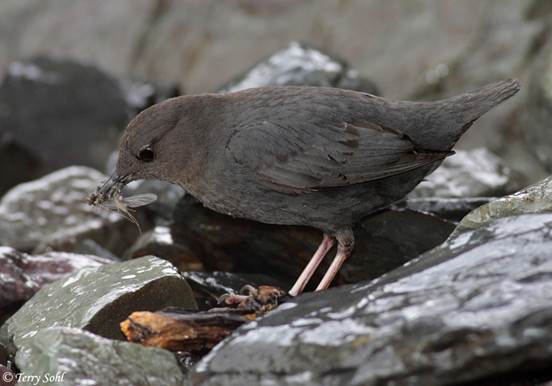…the most wonderful singer of all the birds is the water-ouzel that dives into foaming rapids and feeds at the bottom, holding on in a wonderful way, living a charmed life. —John Muir 1894
This is North America’s truly aquatic song bird. It is a chunky little bird that lives along fast moving streams and rivers and captures all its food by swimming or walking on the stream bottom. Walking along the rocky streambank they will suddenly plunge into the fast moving water, often surfacing upstream from where they entered the water. The dipper will feed upon aquatic insects and their larvae, small crayfish, caddisfly larvae, and sometimes tadpoles. They are known to dive as deep as 20 ft. underwater after their prey. http://www.bing.com/videos/search?q=american+dipper&FORM=VIRE1#view=detail&mid=EE914E1FC10E53997142EE914E1FC10E53997142https://www.youtube.com/watch?v=cV6IDY1TSC0
Special adaptations allow them to dive under the water year round. These include a thick insulation of feathers, the ability to carry extra oxygen in their blood, a relatively low metabolic rate, and scales that close their nostrils when they dive. They also have “nictitating membranes” that act as an extra, clear eyelid that allows them to see underwater. Dippers also produce copious amounts of oil from glands that they spread on their feathers while preening as waterproofing.
In the summer they molt their wing and tail feathers all at once and are flightless at this time, in contrast to most passerine (song birds) that have a progressive molt and can always fly. I’m not clear on why this is so – possibly a progressive molt would just keep them less functional in the water for a longer time and it’s easier to just get the molt done in one quick bout. But it must have some advantage as they are more vulnerable during this flightless period. This bird was first described in 1827 in Mexico, thus the species name.

The dipper also is known by the more charming name of water ouzel. This bird can be found along fast moving, rocky streams in the mountains of Central America, through western North America, and into Alaska. Dippers can be found in habitats ranging from sea level up to 12,000 ft. Because they are associated with cool, clean water, dippers are an indicator of water quality.Dippers are uniformly gray and about 7 inches long. When out of water they have the constant habit of bobbing up and down. The name dipper comes from their foraging techniques that take them in and out of the water, but they could just as easily been named bobber. http://www.bing.com/videos/search?q=american+dipper&FORM=VIRE3#view=detail&mid=48646AE3D2D0D1E8015E48646AE3D2D0D1E8015E
There is one record of them being eaten by a Dolly Varden trout, which also inhabit fast moving, clear streams. Nests are located behind waterfalls, on rock ledges or on the streambank close to the water. The nest is globe shaped with a side entrance. Two to four eggs are laid at a time and incubated solely by the female and take about 16 days to hatch. The male will bring food to the female and the young and the hatchlings leave the nest after about 23 days.
John Muir seemed especially smitten with this plump and hardy bird: Among all the countless waterfalls I have met in the course of ten years’ exploration in the Sierra, whether among the icy peaks, or warm foot-hills, or in the profound yosemitic cañons of the middle region, not one was found without its Ouzel. No cañon is too cold for this little bird, none too lonely, provided it be rich in falling water. Find a fall, or cascade, or rushing rapid, anywhere upon a clear stream, and there you will surely find its complementary Ouzel, flitting about in the spray, diving in foaming eddies, whirling like a leaf among beaten foam-bells; ever vigorous and enthusiastic, yet self-contained, and neither seeking nor shunning your company…
Steve Winter and I were out about in the field last week on the Mill Pond Dam removal project, which is on Sullivan Creek, a tributary to the Pend Oreille River, tucked into the NE corner of WA adjacent to Idaho and Canada. One of the bank restoration sites we needed to visit was upstream of the Mill Pond that required the crossing of Sullivan Creek. We had seen several dippers throughout the day popping in and out of the water, foraging underwater, and generally hanging along the stream side.
Before leaving the office we purposely left behind our chest waders and opted for knee boots because well, we knew (or thought we knew) the stream flow would be pretty low this time of year, particularly because of the relatively dry year. Except — we forgot to account for the late season irrigation releases from the upstream Sullivan Lake dam and didn’t bother to check the on-line stream gage data. That was a mistake. We managed only to fill our boots on the initial crossing early in the day. It was sunny and therefore not so bad. On the way back we opted for the short cut knowing we were going to get a lot damper than a dipper – and it played out as expected. https://vimeo.com/143796485
